[English] 日本語
 Yorodumi
Yorodumi- PDB-2go5: Structure of signal recognition particle receptor (SR) in complex... -
+ Open data
Open data
- Basic information
Basic information
| Entry | Database: PDB / ID: 2go5 | ||||||
|---|---|---|---|---|---|---|---|
| Title | Structure of signal recognition particle receptor (SR) in complex with signal recognition particle (SRP) and ribosome nascent chain complex | ||||||
 Components Components |
| ||||||
 Keywords Keywords | TRANSLATION/RNA / SR / SRP /  RIBOSOME / TRANSLATION-RNA COMPLEX RIBOSOME / TRANSLATION-RNA COMPLEX | ||||||
| Function / homology |  Function and homology information Function and homology informationSRP-dependent cotranslational protein targeting to membrane /  signal recognition particle receptor complex / SRP-dependent cotranslational protein targeting to membrane, signal sequence recognition / endoplasmic reticulum signal peptide binding / signal recognition particle receptor complex / SRP-dependent cotranslational protein targeting to membrane, signal sequence recognition / endoplasmic reticulum signal peptide binding /  signal recognition particle, endoplasmic reticulum targeting / signal recognition particle, endoplasmic reticulum targeting /  signal recognition particle binding / granulocyte differentiation / cotranslational protein targeting to membrane / signal recognition particle binding / granulocyte differentiation / cotranslational protein targeting to membrane /  signal-recognition-particle GTPase / protein targeting to ER ...SRP-dependent cotranslational protein targeting to membrane / signal-recognition-particle GTPase / protein targeting to ER ...SRP-dependent cotranslational protein targeting to membrane /  signal recognition particle receptor complex / SRP-dependent cotranslational protein targeting to membrane, signal sequence recognition / endoplasmic reticulum signal peptide binding / signal recognition particle receptor complex / SRP-dependent cotranslational protein targeting to membrane, signal sequence recognition / endoplasmic reticulum signal peptide binding /  signal recognition particle, endoplasmic reticulum targeting / signal recognition particle, endoplasmic reticulum targeting /  signal recognition particle binding / granulocyte differentiation / cotranslational protein targeting to membrane / signal recognition particle binding / granulocyte differentiation / cotranslational protein targeting to membrane /  signal-recognition-particle GTPase / protein targeting to ER / XBP1(S) activates chaperone genes / SRP-dependent cotranslational protein targeting to membrane, translocation / 7S RNA binding / exocrine pancreas development / SRP-dependent cotranslational protein targeting to membrane / SRP-dependent cotranslational protein targeting to membrane / ribonucleoprotein complex binding / cytoplasmic microtubule / maturation of LSU-rRNA from tricistronic rRNA transcript (SSU-rRNA, 5.8S rRNA, LSU-rRNA) / signal-recognition-particle GTPase / protein targeting to ER / XBP1(S) activates chaperone genes / SRP-dependent cotranslational protein targeting to membrane, translocation / 7S RNA binding / exocrine pancreas development / SRP-dependent cotranslational protein targeting to membrane / SRP-dependent cotranslational protein targeting to membrane / ribonucleoprotein complex binding / cytoplasmic microtubule / maturation of LSU-rRNA from tricistronic rRNA transcript (SSU-rRNA, 5.8S rRNA, LSU-rRNA) /  chloroplast / chloroplast /  neutrophil chemotaxis / GDP binding / cytosolic large ribosomal subunit / neutrophil chemotaxis / GDP binding / cytosolic large ribosomal subunit /  rRNA binding / rRNA binding /  ribosome / structural constituent of ribosome / nuclear speck / ribosome / structural constituent of ribosome / nuclear speck /  translation / translation /  ribonucleoprotein complex / ribonucleoprotein complex /  mRNA binding / mRNA binding /  GTPase activity / GTPase activity /  ubiquitin protein ligase binding / GTP binding / endoplasmic reticulum membrane / ubiquitin protein ligase binding / GTP binding / endoplasmic reticulum membrane /  endoplasmic reticulum / endoplasmic reticulum /  ATP hydrolysis activity / ATP hydrolysis activity /  RNA binding / extracellular exosome / RNA binding / extracellular exosome /  membrane / membrane /  nucleus / nucleus /  cytosol / cytosol /  cytoplasm cytoplasmSimilarity search - Function | ||||||
| Biological species |    Homo sapiens (human) Homo sapiens (human)  Mus musculus (house mouse) Mus musculus (house mouse) | ||||||
| Method |  ELECTRON MICROSCOPY / ELECTRON MICROSCOPY /  single particle reconstruction / single particle reconstruction /  cryo EM / Resolution: 7.4 Å cryo EM / Resolution: 7.4 Å | ||||||
 Authors Authors | Halic, M. / Gartmann, M. / Schlenker, O. / Mielke, T. / Pool, M.R. / Sinning, I. / Beckmann, R. | ||||||
 Citation Citation |  Journal: Science / Year: 2006 Journal: Science / Year: 2006Title: Signal recognition particle receptor exposes the ribosomal translocon binding site. Authors: Mario Halic / Marco Gartmann / Oliver Schlenker / Thorsten Mielke / Martin R Pool / Irmgard Sinning / Roland Beckmann /  Abstract: Signal sequences of secretory and membrane proteins are recognized by the signal recognition particle (SRP) as they emerge from the ribosome. This results in their targeting to the membrane by ...Signal sequences of secretory and membrane proteins are recognized by the signal recognition particle (SRP) as they emerge from the ribosome. This results in their targeting to the membrane by docking with the SRP receptor, which facilitates transfer of the ribosome to the translocon. Here, we present the 8 angstrom cryo-electron microscopy structure of a "docking complex" consisting of a SRP-bound 80S ribosome and the SRP receptor. Interaction of the SRP receptor with both SRP and the ribosome rearranged the S domain of SRP such that a ribosomal binding site for the translocon, the L23e/L35 site, became exposed, whereas Alu domain-mediated elongation arrest persisted. | ||||||
| History |
| ||||||
| Remark 999 | SEQUENCE Residue (A G 124) and Residue (A G 125) are not linked. Distance of O3*-P bond is 4.22. ...SEQUENCE Residue (A G 124) and Residue (A G 125) are not linked. Distance of O3*-P bond is 4.22. Residue (A C 221) and Residue (A G 222) are not linked. Distance of O3*-P bond is 3.26. Residue (1 SER 0) and Residue (1 MET 1) are not linked. Distance of C-N bond is 17.58. Residue (1 GLY 27) and Residue (1 PRO 28) are not linked. Distance of C-N bond is 7.21. Residue (1 LEU 52) and Residue (1 THR 53) are not linked. Distance of C-N bond is 5.58. |
- Structure visualization
Structure visualization
| Movie |
 Movie viewer Movie viewer |
|---|---|
| Structure viewer | Molecule:  Molmil Molmil Jmol/JSmol Jmol/JSmol |
- Downloads & links
Downloads & links
- Download
Download
| PDBx/mmCIF format |  2go5.cif.gz 2go5.cif.gz | 281.6 KB | Display |  PDBx/mmCIF format PDBx/mmCIF format |
|---|---|---|---|---|
| PDB format |  pdb2go5.ent.gz pdb2go5.ent.gz | 220 KB | Display |  PDB format PDB format |
| PDBx/mmJSON format |  2go5.json.gz 2go5.json.gz | Tree view |  PDBx/mmJSON format PDBx/mmJSON format | |
| Others |  Other downloads Other downloads |
-Validation report
| Arichive directory |  https://data.pdbj.org/pub/pdb/validation_reports/go/2go5 https://data.pdbj.org/pub/pdb/validation_reports/go/2go5 ftp://data.pdbj.org/pub/pdb/validation_reports/go/2go5 ftp://data.pdbj.org/pub/pdb/validation_reports/go/2go5 | HTTPS FTP |
|---|
-Related structure data
| Related structure data |  1217MC M: map data used to model this data C: citing same article ( |
|---|---|
| Similar structure data |
- Links
Links
- Assembly
Assembly
| Deposited unit | 
|
|---|---|
| 1 |
|
- Components
Components
-RNA chain , 2 types, 2 molecules A9
| #1: RNA chain |  Signal recognition particle RNA Signal recognition particle RNAMass: 41199.570 Da / Num. of mol.: 1 / Source method: isolated from a natural source / Source: (natural)  |
|---|---|
| #2: RNA chain |  Mass: 29170.479 Da / Num. of mol.: 1 / Source method: isolated from a natural source / Source: (natural)  |
-Signal recognition particle ... , 4 types, 4 molecules BW12
| #3: Protein | Mass: 12561.688 Da / Num. of mol.: 1 Source method: isolated from a genetically manipulated source Source: (gene. exp.)  |
|---|---|
| #4: Protein | Mass: 12473.440 Da / Num. of mol.: 1 Source method: isolated from a genetically manipulated source Source: (gene. exp.)  |
| #5: Protein | Mass: 21329.512 Da / Num. of mol.: 1 Source method: isolated from a genetically manipulated source Source: (gene. exp.)   Homo sapiens (human) / References: UniProt: P08240 Homo sapiens (human) / References: UniProt: P08240 |
| #6: Protein | Mass: 23536.982 Da / Num. of mol.: 1 Source method: isolated from a genetically manipulated source Source: (gene. exp.)   Mus musculus (house mouse) / References: UniProt: P47758 Mus musculus (house mouse) / References: UniProt: P47758 |
-Ribosomal protein ... , 3 types, 3 molecules 546
| #7: Protein |  Mass: 14401.041 Da / Num. of mol.: 1 Source method: isolated from a genetically manipulated source Source: (gene. exp.)  |
|---|---|
| #8: Protein |  Mass: 16920.203 Da / Num. of mol.: 1 Source method: isolated from a genetically manipulated source Source: (gene. exp.)  |
| #9: Protein |  Mass: 14152.365 Da / Num. of mol.: 1 Source method: isolated from a genetically manipulated source Source: (gene. exp.)  |
-Experimental details
-Experiment
| Experiment | Method:  ELECTRON MICROSCOPY ELECTRON MICROSCOPY |
|---|---|
| EM experiment | Aggregation state: PARTICLE / 3D reconstruction method:  single particle reconstruction single particle reconstruction |
- Sample preparation
Sample preparation
| Component | Name: SR-SRP-RNC COMPLEX / Type: RIBOSOME |
|---|---|
| Specimen | Embedding applied: NO / Shadowing applied: NO / Staining applied : NO / Vitrification applied : NO / Vitrification applied : YES : YES |
| Specimen support | Details: CARBON |
Vitrification | Cryogen name: ETHANE |
- Electron microscopy imaging
Electron microscopy imaging
| Experimental equipment |  Model: Tecnai F30 / Image courtesy: FEI Company |
|---|---|
| Microscopy | Model: FEI TECNAI F30 |
| Electron gun | Electron source : :  FIELD EMISSION GUN / Accelerating voltage: 300 kV / Illumination mode: FLOOD BEAM FIELD EMISSION GUN / Accelerating voltage: 300 kV / Illumination mode: FLOOD BEAM |
| Electron lens | Mode: BRIGHT FIELD Bright-field microscopy / Nominal defocus max: 3500 nm / Nominal defocus min: 800 nm Bright-field microscopy / Nominal defocus max: 3500 nm / Nominal defocus min: 800 nm |
| Image recording | Film or detector model: KODAK SO-163 FILM |
| Radiation | Protocol: SINGLE WAVELENGTH / Monochromatic (M) / Laue (L): M |
| Radiation wavelength | Relative weight: 1 |
- Processing
Processing
| Symmetry | Point symmetry : C1 (asymmetric) : C1 (asymmetric) | ||||||||||||
|---|---|---|---|---|---|---|---|---|---|---|---|---|---|
3D reconstruction | Resolution: 7.4 Å / Resolution method: FSC 0.5 CUT-OFF / Symmetry type: POINT | ||||||||||||
| Refinement | Highest resolution: 7.4 Å | ||||||||||||
| Refinement step | Cycle: LAST / Highest resolution: 7.4 Å
|
 Movie
Movie Controller
Controller


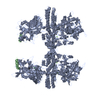
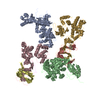


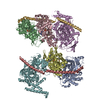

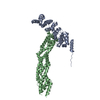
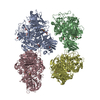
 PDBj
PDBj
































